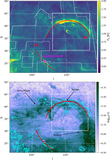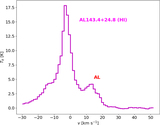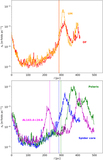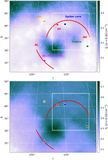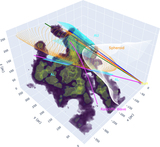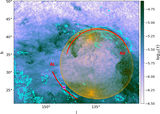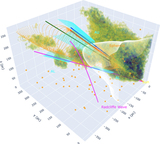Image Details
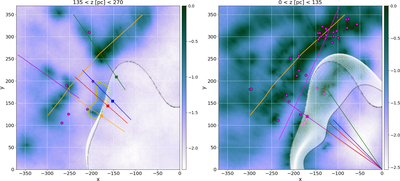
Caption: Figure 6.
Top-down view of the second quadrant of s x , integrated perpendicular to the Galactic plane (logarithmic form) for two layers above the plane: 135 < z < 270 pc (left) and 0 < z < 135 pc (right). The Sun is at (0,0) and the Galactic anticenter direction (l = 180°) is toward the lower left corner. Fuchsia dots show the projected positions of molecular clouds in the layer of interest from Zucker et al. (2019). The solid orange curve shows the projected orientation of the curved plane that includes material to the west of Polaris, the Polaris pillar, and Ursa Major. The yellow contour in the higher-z layer (left) shows the coherent structure that includes the Spider and its extension to the east located at x = −190 pc, y = 130 pc, and that in projection on the sky connects to Ursa Major and contributes to what is called the NCPL. The solid magenta line in the bottom panel shows the projected position of the best-fit model of the Radcliffe wave (Alves et al. 2020), which in this quadrant is above the Galactic plane in the lower layer. For orientation, projected path for the extinction density profiles from Figure 4 are shown by solid lines on each panel in the volume of interest, using the same color code. The white drapery pattern shows projections of the inner surface of the P20 LB at various heights within each layer of interest; for orientation, the projections are black for z = 0 pc and z = 135 pc. Colored squares show its intersection with the projected paths; these are the projections from the vertical-line positions shown in Figure 4.
Copyright and Terms & Conditions
© 2023. The Author(s). Published by the American Astronomical Society.


